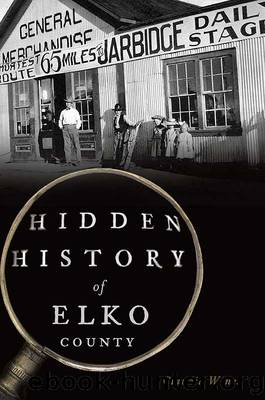Hidden History of Elko County by Claudia Wines

Author:Claudia Wines
Language: eng
Format: epub
Publisher: Arcadia Publishing Inc.
Published: 2017-09-15T00:00:00+00:00
The dam in Bishop Creek Canyon before the lack of water rights prevented further use of the dam. Courtesy of Northeastern Nevada Museum.
There was no road to the site, and all transportation between Wells and the dam was done with horse teams and wagons. After constructing the road, work began on a camp for the three hundred workers and more than one hundred horses and mules. Bunkhouses, a cookhouse, stables, corrals, a warehouse, a blacksmith shop, a store and, of course, a saloon were all needed.
Work began in the spring of 1911; it took just over a year and cost $200,000. It required 250,000 cubic yards of earth fill, masonry rubble and reinforced concrete. Some of the fill came from cleanup debris after the San Francisco Earthquake five years earlier. All supplies arrived in Wells by train and were hauled to the dam in wagons. The crews worked around the clock, using acetylene lamps at night. The key to dealing with the cold Elko County winter was more whiskey in the saloon.
Historians and engineers still marvel at the project. âI canât understand how he built it,â said Bill Heyenbruch of the U.S. Corps of Engineers in Sacramento in 1973. âEven today with the latest technology, the task would be staggering. In 1911, it was something of a miracle.â
Things did not end well for P.J. Moran. In spite of his amazing feat, he never received the $83,000 that Pacific Reclamation owed him. This created a serious financial setback, from which he never completely recovered.
While construction of the dam was progressing, things started happening in the new town. Streets were laid out and lots sold to eager folks who wanted to own a piece of the dream. The founders envisioned a city of seventy-five hundred people, and buildings started popping up in the sagebrush. An eight-mile spur from the nearby transcontinental railroad connected Metropolis to the world.
A large, elegant hotel was one of the first structures built. Constructed of brick and concrete, it was three stories high with a full basement. When finished by yearâs end, 1911, it was considered the finest such establishment between Ogden, Utah, and San Francisco. There were fifty guest rooms, thirty with their own baths, and every room had hot and cold running water. A thirtytwo-horsepower diesel generator in the basement furnished electricity for more than 450 lights in the hotel and for all the other buildings in town. The surrounding farms still used kerosene lanterns and would not have electricity until 1958. All the hotel rooms were steam-heated from a large boiler in the basement. There was an electric elevator and central vacuum system.
More than three hundred people attended the grand opening of the hotel, including dignitaries, politicians and the press from all over northern Nevada and nearby Utah. The Elko Daily Free Press stated it was the place to be in Elko County on that evening. A chef from Atlanta, Georgia, prepared the large banquet, after which guests danced into the morning hours.
Download
This site does not store any files on its server. We only index and link to content provided by other sites. Please contact the content providers to delete copyright contents if any and email us, we'll remove relevant links or contents immediately.
Niceville by Carsten Stroud(2775)
Tokyo by Rob Goss(2348)
Lonely Planet's Guide to Travel Photography by Lonely Planet(1800)
Letter to My Daughter by Maya Angelou(1716)
Arctic Dreams by Barry Lopez(1703)
The Source by James A. Michener(1505)
Ceremony In Death by J D Robb(1475)
Tolkien, J. R. R. - The Fellowship of the Ring by Tolkien J. R. R(1441)
Nothing to Envy by Barbara Demick(1358)
The Lord of the Rings: The Fellowship of the Ring, the Two Towers, the Return of the King by J. R. R. Tolkien(1353)
The Elements of Eloquence by Mark Forsyth(1318)
The Price of Salt, or Carol by Patricia Highsmith(1234)
Epic Hikes of the World by Lonely Planet(1232)
The Cities by K.A Knight(1210)
African Nights by Kuki Gallmann(1202)
The Fellowship of the Ring (The Lord of the Rings, Book 1) by J. R. R. Tolkien(1143)
Trieste and the Meaning of Nowhere by Jan Morris(1057)
The Safe Word by Karen Long(1020)
Lonely Planet Epic Drives of the World by Lonely Planet(1005)
